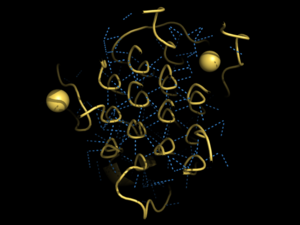Sandbox Reserved 1726
From Proteopedia
(Difference between revisions)
| Line 21: | Line 21: | ||
The full-length ALKAL2 (dimeric) and ALKAL2-AD (monomeric) can both induce dimerization of ALK <ref name="Reshetnyak">PMID:34819673</ref>. | The full-length ALKAL2 (dimeric) and ALKAL2-AD (monomeric) can both induce dimerization of ALK <ref name="Reshetnyak">PMID:34819673</ref>. | ||
==== ALKAL1 ==== | ==== ALKAL1 ==== | ||
| - | + | ALKAL1 (Anaplastic Lymphoma Kinase Ligand 1) is a monomeric ligand of ALK, in addition to ALKAL2. Structurally, ALKAL1 and ALKAL2 contain an N-terminal variable region and a conversed C-terminal augmentor domain <ref name="Reshetnyak" />. However, in ALKAL1, this N-terminal variable region is shorter, and shares no similar sequences to ALKAL2. Nevertheless, ALKAL1 shares a 91% sequence similarity with ALKAL2. Both ligands include a three helix bundle domain in their structures, with an extended positively charged surface which is used in ligand binding <ref name="Reshetnyak" />. | |
=== Dimerization of Anaplastic Lymphoma Kinase === | === Dimerization of Anaplastic Lymphoma Kinase === | ||
After binding to one of its ligands, Anaplastic Lymphoma Kinase undergoes <scene name='90/904331/Alk_full_dimerization/1'>ligand-induced dimerization</scene> <ref name="Huang">PMID:30400214</ref>. The dimerization causes trans-phosphorylation of specific tyrosine residues which in turn amplifies the signal. It has been presumed that the phosphorylation cascade activates ALK kinase activity <ref name="Huang" />. | After binding to one of its ligands, Anaplastic Lymphoma Kinase undergoes <scene name='90/904331/Alk_full_dimerization/1'>ligand-induced dimerization</scene> <ref name="Huang">PMID:30400214</ref>. The dimerization causes trans-phosphorylation of specific tyrosine residues which in turn amplifies the signal. It has been presumed that the phosphorylation cascade activates ALK kinase activity <ref name="Huang" />. | ||
Revision as of 21:01, 28 March 2022
| This Sandbox is Reserved from February 28 through September 1, 2022 for use in the course CH462 Biochemistry II taught by R. Jeremy Johnson at the Butler University, Indianapolis, USA. This reservation includes Sandbox Reserved 1700 through Sandbox Reserved 1729. |
To get started:
More help: Help:Editing |
Anaplastic Lymphoma Kinase Extracellular Region
| |||||||||||
References
- ↑ 1.0 1.1 1.2 Reshetnyak AV, Rossi P, Myasnikov AG, Sowaileh M, Mohanty J, Nourse A, Miller DJ, Lax I, Schlessinger J, Kalodimos CG. Mechanism for the activation of the anaplastic lymphoma kinase receptor. Nature. 2021 Dec;600(7887):153-157. doi: 10.1038/s41586-021-04140-8. Epub 2021, Nov 24. PMID:34819673 doi:http://dx.doi.org/10.1038/s41586-021-04140-8
- ↑ 2.0 2.1 2.2 Huang H. Anaplastic Lymphoma Kinase (ALK) Receptor Tyrosine Kinase: A Catalytic Receptor with Many Faces. Int J Mol Sci. 2018 Nov 2;19(11). pii: ijms19113448. doi: 10.3390/ijms19113448. PMID:30400214 doi:http://dx.doi.org/10.3390/ijms19113448
- ↑ Li T, Stayrook SE, Tsutsui Y, Zhang J, Wang Y, Li H, Proffitt A, Krimmer SG, Ahmed M, Belliveau O, Walker IX, Mudumbi KC, Suzuki Y, Lax I, Alvarado D, Lemmon MA, Schlessinger J, Klein DE. Structural basis for ligand reception by anaplastic lymphoma kinase. Nature. 2021 Dec;600(7887):148-152. doi: 10.1038/s41586-021-04141-7. Epub 2021, Nov 24. PMID:34819665 doi:http://dx.doi.org/10.1038/s41586-021-04141-7


